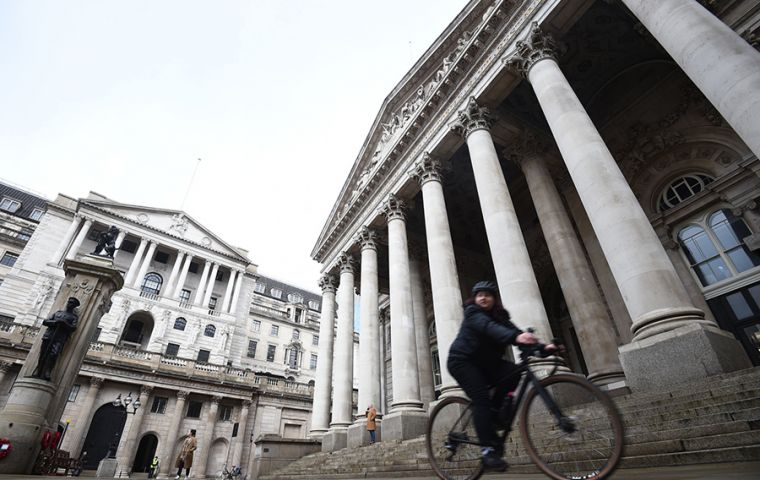MercoPress. South Atlantic News Agency
Bank of England tells banks to prepare for negative interest rates
 The central bank’s Prudential Regulation Authority said most financial institutions aren’t sufficiently prepared, especially as regards to retail products
The central bank’s Prudential Regulation Authority said most financial institutions aren’t sufficiently prepared, especially as regards to retail products The Bank of England (BOE) told banks to start getting ready for negative interest rates but added that the message shouldn’t be taken as a signal that the policy is imminent. The BOE made the announcement as it held its key rate at a record low of 0.1%.
The central bank’s Prudential Regulation Authority said most financial institutions aren’t sufficiently prepared, especially as regards to retail products like rate-tracking mortgages, so they should take at least six months to set their systems up without running undue risks.
The move raises the threat that the central bank will push borrowing costs below zero, turning the lending business on its head by charging depositors to store cash while giving money back to borrowers.
The BOE has been studying the case for negative rates for almost a year as a way to pull the U.K. out of its worst slump in three centuries. So far, it hasn’t followed counterparts in Europe and Japan in implementing the policy.
Many banks said their retail banking systems were “not built to accommodate a negative bank rate, and substantive changes would need to be made,” Sam Woods, who heads the PRA, said in a letter to financial executives that was released Thursday. He didn’t specify any banks by name.
Still, the central bank emphasized that such a radical change in policy may not occur, and that its banking-regulation arm wasn’t giving a signal about the future intentions of its monetary-policy side. That outlook lifted the pound, while money markets trimmed bets on a cut: they’re now pricing 4 basis points of easing by December, compared to 8 basis points ahead of the decision.
“The Monetary Policy Committee stressed again that these requests, and any subsequent related supervisory actions determined by the Prudential Regulation Authority, should not be interpreted as a signal that the setting of a negative Bank Rate or a tiered system of reserve remuneration were imminent, or indeed in prospect at any time,” the BOE said.
The issue was a real concern for members of the MPC: it was divided on whether to ask banks to start the work, with some members believing the economy wasn’t troubled enough to contemplate the policy and worried that the request to banks could be misconstrued, according to the minutes of the latest meeting.
“My message to markets is you really should not try to read the future behavior of the MPC from the actions we’re taking on our toolbox,” Governor Andrew Bailey said in a webcast after the report.
The European Central Bank became the first major monetary authority to cut interest rates below zero in June 2014, a year after the euro zone exited a double-dip recession, when it was worried that a too-strong exchange rate was depressing inflation.
Its deposit rate has continued to be reduced since and is now at a record-low -0.5%. It wasn’t cut during the pandemic, in part because of concerns that the pain it inflicts on banks undermines its effectiveness.
Should it end up cutting below zero, the BOE also said it will start its own work on a tiered rate system. Both the ECB and the Swiss National Bank have tier systems that exempt some lenders’ deposits from negative rates -- an effective tax on their reserves that they struggle to pass onto customers.
It’s helpful that the BOE is specifying the six-month preparation time, said John Garvey, global financial services leader at PwC. He compared it to the investment rush more than 20 years ago to make sure the millennium wouldn’t disrupt date-based information technology.
“It is a bit of a ‘Y2K’ moment,” Garvey said. “There are an enormous number of models, systems and contracts that will need to be addressed.”

![“Working directly with President [Donald] Trump and Congress, we accomplished what no one else could,” Patel stressed](/data/cache/noticias/108417/130x80/fbi.jpg)


Top Comments
Disclaimer & comment rulesCommenting for this story is now closed.
If you have a Facebook account, become a fan and comment on our Facebook Page!